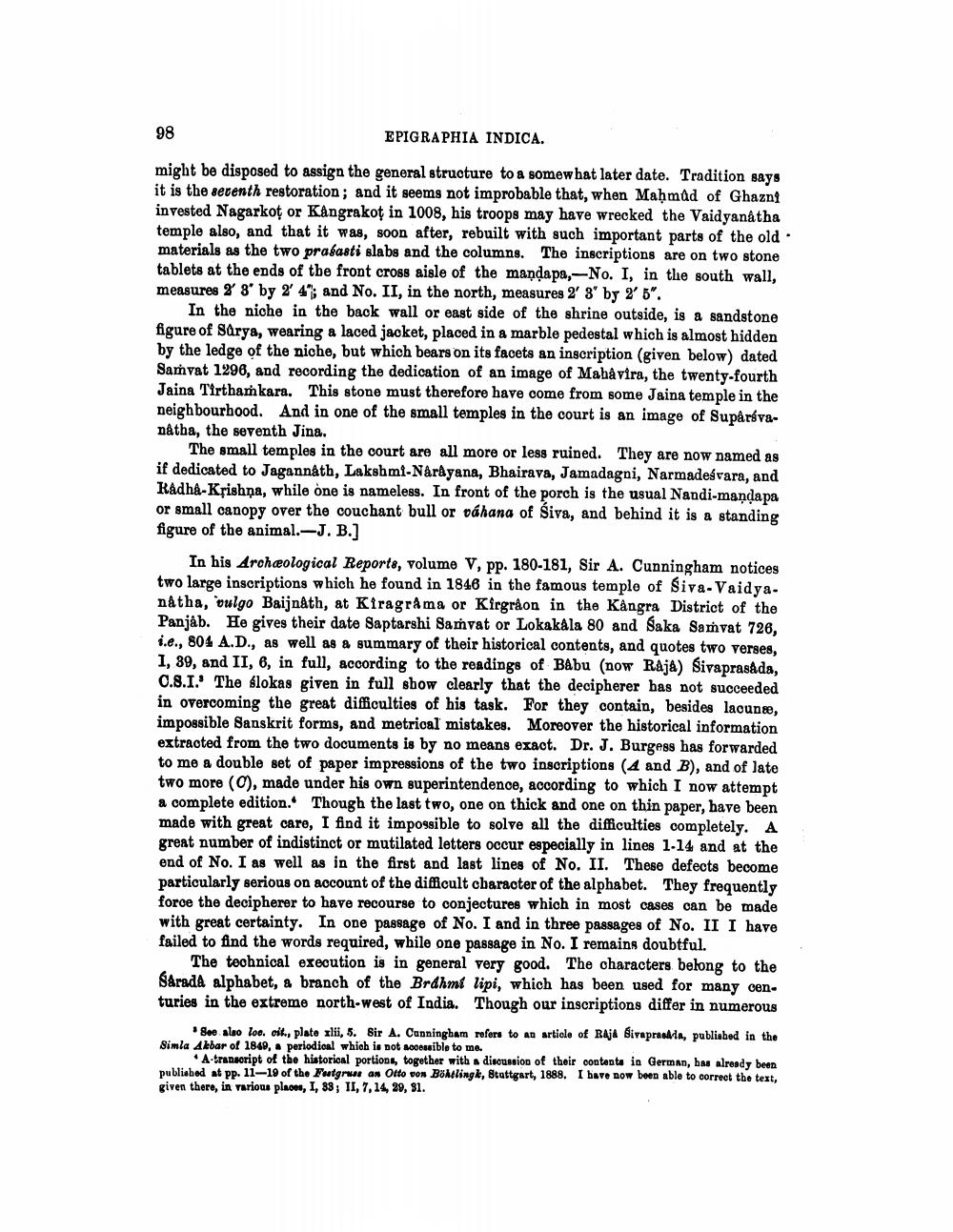________________
98
EPIGRAPHIA INDICA.
might be disposed to assign the general structure to a somewhat later date. Tradition says it is the seventh restoration; and it seems not improbable that, when Mahmûd of Ghazni invested Nagarkot or Kângrakot in 1008, his troops may have wrecked the Vaidyanatha temple also, and that it was, soon after, rebuilt with such important parts of the old ⚫ materials as the two prasasti slabs and the columns. The inscriptions are on two stone tablets at the ends of the front cross aisle of the mandapa,-No. I, in the south wall, measures 2' 3' by 2' 4"; and No. II, in the north, measures 2' 3" by 2' 5".
In the niche in the back wall or east side of the shrine outside, is a sandstone figure of Surya, wearing a laced jacket, placed in a marble pedestal which is almost hidden by the ledge of the niche, but which bears on its facets an inscription (given below) dated Samvat 1296, and recording the dedication of an image of Mahâvira, the twenty-fourth Jaina Tirthamkara. This stone must therefore have come from some Jaina temple in the neighbourhood. And in one of the small temples in the court is an image of Supârávanatha, the seventh Jina.
The small temples in the court are all more or less ruined. They are now named as if dedicated to Jagannath, Lakshmi-Narayana, Bhairava, Jamadagni, Narmadeśvara, and Radha-Krishna, while one is nameless. In front of the porch is the usual Nandi-maṇḍapa or small canopy over the couchant bull or váhana of Śiva, and behind it is a standing figure of the animal.-J. B.]
In his Archæological Reports, volume V, pp. 180-181, Sir A. Cunningham notices two large inscriptions which he found in 1846 in the famous temple of Siva-Vaidyanatha, vulgo Baijnath, at Kiragrâma or Kirgråon in the Kangra District of the Panjab. He gives their date Saptarshi Samvat or Lokakâla 80 and Saka Samvat 726, i.e., 804 A.D., as well as a summary of their historical contents, and quotes two verses, 1, 39, and II, 6, in full, according to the readings of Babu (now RAJA) Sivaprasada, C.S.I. The slokas given in full show clearly that the decipherer has not succeeded in overcoming the great difficulties of his task. For they contain, besides lacunæ, impossible Sanskrit forms, and metrical mistakes. Moreover the historical information extracted from the two documents is by no means exact. Dr. J. Burgess has forwarded to me a double set of paper impressions of the two inscriptions (A and B), and of late two more (C), made under his own superintendence, according to which I now attempt a complete edition. Though the last two, one on thick and one on thin paper, have been made with great care, I find it impossible to solve all the difficulties completely. A great number of indistinct or mutilated letters occur especially in lines 1-14 and at the end of No. I as well as in the first and last lines of No. II. These defects become particularly serious on account of the difficult character of the alphabet. They frequently force the decipherer to have recourse to conjectures which in most cases can be made with great certainty. In one passage of No. I and in three passages of No. II I have failed to find the words required, while one passage in No. I remains doubtful.
The technical execution is in general very good. The characters belong to the Sarada alphabet, a branch of the Brahmi lipi, which has been used for many centuries in the extreme north-west of India. Though our inscriptions differ in numerous
See also loc. cit., plate xlii, 5. Sir A. Cunningham refers to an article of Raja Sivaprasada, published in the Simla Akbar of 1849, a periodical which is not accessible to me.
A-transcript of the historical portions, together with a discussion of their contents in German, has already been published at pp. 11-19 of the Festgrass an Otto von Böhlingk, Stuttgart, 1888. I have now been able to correct the text, given there, in various places, I, 33; II, 7, 14, 29, 31.




